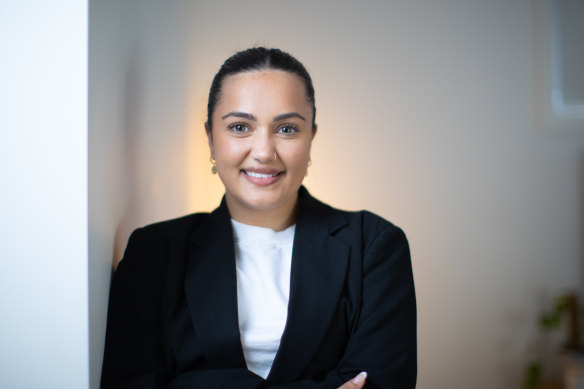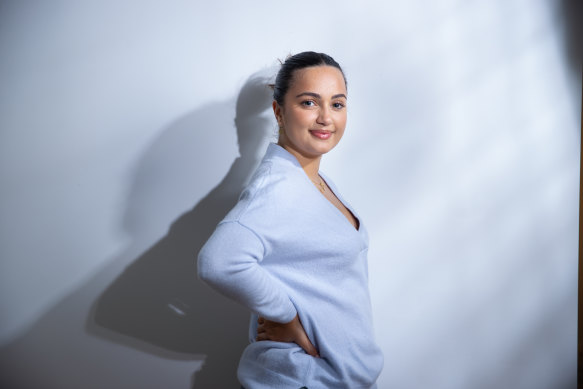Tahlia had a stroke at age 10. Today, doing her own hair is an accomplishment
“Good, thanks” is the response often given by those with a chronic illness or disability when asked how they are – despite this being far from their reality. This series looks behind the masks of those living with chronic illness and takes you into their world.
Most 25-year-olds start their day getting ready for work, maybe grabbing a coffee or fitting in a morning workout. Not Tahlia Dias.
You may not know it by looking at her, but the effort and planning it takes to get out of her house each morning is something most people couldn’t imagine.

Tahlia Dias had a stroke at age 10.Credit: Simon Schluter
“Everything takes longer and is harder to do with one hand, like my hair and make-up,” says Dias, who lives in Melbourne.
Dias had a stroke at school camp when she was just 10. After feeling unwell on the bus, she noticed one arm felt numb. She simply thought the feeling was funny and didn’t think more of it, until she went down a waterslide and, after reaching the bottom, couldn’t stand up.
“I had to be pulled out of the water. When they sat me up I couldn’t walk or talk.”
After being flown to hospital, her parents, Neeva and Alister, were told it was unlikely their daughter would walk or talk again. And while Dias has defied those odds, she returned to school in a wheelchair.
Today, her left hand and arm are paralysed, and she hasn’t regained strength in her left leg, affecting her ability to walk. She says it’s both a blessing and a curse that, at first glance, people often don’t know she is disabled.
“That makes it harder sometimes,” she says. “I find myself trying to explain why I can’t do something because of my fatigue or why I can’t do that five-kilometre run. People might say, ‘Just try, you’ll be fine’, but it doesn’t work like that – I’m not fine.
“When I’ve gone to nightclubs, I’ve been told I’m too drunk – I don’t drink. But they’ll say, ‘You’re walking funny, you can’t come in’. At the end of the day, when I’m really fatigued, I don’t have good balance and my words don’t come out properly.”
Of all the neurological disorders, stroke is the largest cause of adult disability in Australia. The median age for stroke is 75. However, almost 600 Australian children annually suffer a stroke.
Of the 70 per cent of Australians whose stroke isn’t fatal, 25 per cent will not recover completely. Dias is in that group. While she can live independently, it’s not without its challenges.
“My parents are everything to me – my mum is my best friend – but I’ve grown the most in the past two years because I don’t have their help [at home],” she says. “Even though it’s hard, I don’t want that growth to slow down.”
Dias does, however, enlist the help of her boyfriend of three years, Jordan, to help out when he stays over at her place. “He’s getting better at doing a ponytail, I’m really proud of him. He’s also great with things around the house, like my bedsheets. It’s impossible to do things like that on my own.”
After getting her Certificate III in IT, a diploma in IT at La Trobe University and a Bachelor of Business at Macquarie University, Dias is working full-time at a large technology company.

Dias works full-time in tech, where she is open about her disability with managers and close co-workers.Credit: Simon Schluter
But while she is close to her managers and some co-workers, not all know of her daily struggles, which is why she is often asked why she is limping or being told “hopefully you’re better next week”.
“The other day, I had on these new pants – which are beautiful – that don’t have buttons, but have a zip on the side,” she says. “I went to the toilet at work and after being in there for 45 minutes I walked out sweating because I couldn’t do it. I got a UTI [urinary tract infection].”
These very real issues are often the ones Dias keeps private. “I find myself saying, ‘Good, thanks’ when people ask me how my day is a lot of time, despite the fact I’m struggling for at least 40 per cent of it. I don’t want people to feel sorry for me – I don’t feel sorry for myself.”
Dias wasn’t always so accepting of the cards she’s been dealt. Unsurprisingly, 36 per cent of people living with a disability in Australia also suffer from depression.
“For the longest time I hadn’t accepted what happened to me,” she admits. “I don’t have the idea any more that I’m going to be completely fine one day – I know I’m not. Some people will have a great recovery, but I’m not one of those people.”
As for her hopes for the future? “My dream is that on my wedding day, I can hold out my left hand. I don’t know if that’s a bit far-fetched, but hey, I’ve always aimed high.”
Brooke Campbell Bayes is a journalist, producer, wife and mother to two young girls. She also has multiple sclerosis. With 49 per cent of Australians living with a chronic illness or disability, she knows she is not alone.
Make the most of your health, relationships, fitness and nutrition with our Live Well newsletter. Get it in your inbox every Monday.